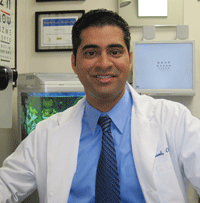For the last seven years, optometrist Justin Prasad has worked hard making his Long Beach, Calif., practice into what he had always dreamed it could be.

Justin Prasad, O.D., is debating whether to hire another doctor for his growing
practice. But, he says, “I’m not sure another O.D. would have the same
passion I exude.”
When Dr. Prasad first purchased the practice in a strip mall in 2005, the office was in a state of disrepair and neglect. The previous owner had used it as a second practice and held doctor’s hours there only two days a week.
Since acquiring the office, Dr. Prasad has done extensive remodeling, expanded the space by 400 square feet, and has plans to do a full professional reconstruction of the optical and front office space in November.
Likewise, Dr. Prasad had his work cut out for him when it came to building up the patient base, as well as their trust. “I’m proud of how much growth we’ve had,” he says. “I used to see four to eight patients a day when I first started. Now I’m booked a week to two weeks out.”
He also went from employing one staff member to four—but when it comes to hiring another optometrist, he has some reservations. “I take so much pride in my office and customer service that I’m not sure another O.D. would have the same passion I exude,” he says. “Maybe I’m wrong. But in the world of online reviews, we are all under the microscope even more.”
Dr. Prasad’s hesitation to bring in an associate to the practice he has poured his heart and soul into reflects the reluctance of other O.D.s as they question whether or not it is or will ever be the right time for them to add an associate.
Why Hire an Associate?
There are at least two big reasons to consider bringing on an associate.
• Covering office hours. One of the reasons why Dr. Prasad is considering hiring another O.D. is to cover the two days a week that he is not there. When he first bought his practice, he began working at an ophthalmologist’s office one day a week to help supplement his income while the practice grew. Although his own practice is now flourishing, he has decided to stay at the ophthalmologist’s office for the experience and for the expanded scope of pathology that he encounters there, which he would be unlikely to see in his own family optometric practice. It also allows him to stay fluent in Spanish and to help serve patients in a disadvantaged area of his community. In addition to his day at the ophthalmology office, he also takes one day a week off to spend time with his growing family.
By hiring an associate doctor, Dr. Prasad would gain coverage at his office on the days when he is not there.
• Finding a likely buyer. Another benefit to adding an associate is the chance to build a relationship with a possible partner or future buyer of the practice. When it comes to taking on a partner, Dr. Prasad isn’t looking that far ahead just yet. “I still feel that it’s too early in my career to tell if I’ll take on a partner,” he says. “It takes a tremendous amount of trust—it’s like a second marriage! So time will tell.”
Successful Teamwork
Many solo practice optometrists would agree that adding an associate and possible potential partner is indeed like entering into a marriage. “You need the right mix,” says Bruce Levinson, O.D., of Syracuse, N.Y. “You are going to spend as much, if not more, time with your business partner as you do your spouse during the week. You have to like and trust the person and, yes, deal with their little quirks and have them be able to handle yours.”
After Dr. Levinson graduated from New England College of Optometry, he worked for an ophthalmologist before opening his own practice cold in 1996, which he eventually merged with his father’s practice in 1997. He recalls, “we had two employees: one part-time secretary and one part-time optician,” he says. “I set a goal of giving superb patient eye care, and by 2000 we had four employees.”

“It takes a tremendous amount of trust” to bring in a partner, says Bruce Levinson, O.D.
In 2001, he hired a young technician out of college. That technician, who would eventually become an optometrist in 2005 and his partner in 2010, was Joseph DiTota, O.D., also a native of the Syracuse area.
When asked why he first considered adding an associate doctor to his then-solo private practice, Dr. Levinson says, “I was at the point where I felt I could not grow without an associate. I could have gone the way I was going and done okay, but not great.”
For his part, Dr. DiTota already had aspirations of becoming an optometrist while studying biology as an undergraduate at SUNY Albany, even before he became a tech at Dr. Levinson’s practice. He and Dr. Levinson discovered they had a lot in common and developed a good working relationship from the start. So when Dr. DiTota decided to go to optometry school, he and Dr. Levinson began to entertain the idea of Dr. DiTota working there as an optometrist upon graduation. And that’s exactly what happened.
“Dr. Levinson became a mentor for me and really showed me the world of optometry from a private practice standpoint. I was very lucky,” Dr. DiTota says.
During his first two years as an associate at Dr. Levinson’s practice, Dr. DiTota continued to receive practical advice and guidance from Dr. Levinson while he refined his exam style and grew his patient base. “It was a great decision for me [to return to work as an O.D. at Dr. Levinson’s practice] because it left me with no doubts that I wanted to become partner,” he says. “I also became familiar with all aspects of the business side of optometry. The staff is very knowledgeable, caring and driven for the practice to succeed, which made the partnership even more attractive.”
Likewise, Dr. Levinson had no reservations about making Dr. DiTota his partner. He had a few other optometrists work at the practice before Dr. DiTota, but “none of them had the dynamic personality that Dr. DiTota has. We are both athletes and seem to communicate with patients in the same light-hearted manner,” he says.
Still, although they got along easily, they both took the process of forming the partnership agreement very seriously. Each step into the partnership was well thought out and pre-planned. Along with the services of a consulting group, they talked about what they each wanted personally out of the practice and the direction in which they would take the practice together.

Being a partner at Dr. Levinson’s practice “was a great decision for me,” says Joseph DiTota, O.D.
Even though Dr. Levinson had the practice evaluated and assessed before, he encouraged Dr. DiTota to have it assessed on his own so that Dr. DiTota would feel even more confident in his investment. When Dr. DiTota’s independent analysis matched Dr. Levinson’s previous evaluation, they proceeded to draw up a contract for the partnership with the help of legal counsel and an accountant.
Dr. Levinson admits that while adding an associate was a bit of a financial strain in the beginning, it has already paid huge dividends. Since they have partnered, their practice, Eyecare of CNY, now has a total of three successful optometric offices in central New York. Each agrees that partnership was the right choice for them.
Things are going so well that they’re even talking about adding a third associate optometrist at some point in the future. However, Dr. DiTota says it is necessary to first “test the waters with outside optometrists who may become potential partners by hiring them for part-time work… or through a full-time salaried position.”
He reasons that if a business partnership is a marriage, then finding the right associate through short-term employment is like dating. “It can really tell you a lot about someone and help to predict if they are the right fit for the office,” he says.
One of the benefits to having someone to lean on is the chance to finally relax and allow someone else to take the reins every once in awhile. “Having a partner can help you to have a better way of life,” Dr. Levinson says.
Now with Dr. DiTota on board, “I know my partner has my back when I am with my family on vacation,” Dr. Levinson says. “It is a great feeling to know someone is tending to the practice back home. It allows me to relax. I was never really comfortable when I was solo and away from the practice.”
Pros and Cons
The partnership of Drs. Levinson and DiTota has been a tremendous success, but some associateships do not result in such favorable outcomes. Optometrist Stuart Rothman, author of the textbook “Business Aspects of Optometry,” as well as a private practice owner and associate clinical professor at SUNY College of Optometry (where he teaches practice management), says that there is much to carefully consider when deciding whether to hire an associate optometrist. It is not a decision to be taken lightly. (See “Is it Time for You to Add an Associate? Four Things to Think About,” below.)
“There are advantages and disadvantages to hiring an associate O.D.,” Dr. Rothman says. Some of the pros include: “A smoother transfer of ownership for an existing practice; an expansion of hours, services and care and economy of scale in purchasing equipment, supplies and inventory.”
Adding an associate can also provide a blending of complementary skills where each O.D. can offer his or her own strengths to widen the patient base. Also, as Dr. Levinson indicated, having an associate allows “the existing O.D. to have increased time off, coverage when ill or away from the practice, and a greater certainty of a potential buyer for the practice,” Dr. Rothman says.
As for the cons of hiring an associate, “unless the practice demand for the associate O.D. is present immediately, there will be an initial decrease in net income for the existing O.D. until the revenue is increased by the presence of the associate,” Dr. Rothman says.
Also, the existing doctor will be “relinquishing some control in the practice, especially if they hope the associateship will lead to an eventual buy-in,” he says. In addition, the practice owner has to be “willing to open up the practice’s financial records and share financial decision making with the associate optometrist.”
Is now the time for you to add an associate? Maybe not. But now’s the time to begin to think it over, at least.
“Anyone who is solo and wants to grow should start looking now,” Dr. Levinson says. “Yes, you need to make a personal sacrifice to bring someone in. You have to allow them to take some of your patients and some of your money to get started. But, having the right associate/partner is invaluable. Your quality of life becomes better and you are not ‘fighting the fight’ alone. You can lean on each other both clinically and in business.”
As for Dr. Prasad, although he has not decided whether an associate O.D. is the right move for his practice, he does have big goals. “I really want to see how far I can take my current office,” he says. And once he has fully mastered his current practice, he plans to expand further and has even looked at purchasing other existing offices nearby.
Dr. Murphy writes frequently on both optometric business and vision science. She is also an associate O.D. at a private practice in Holbrook, N.Y.
|
1. Define what you are looking for.
2. Determine the reasons for the need.
3. Determine the percentage of equity available for the associate O.D. to purchase.
4. Is the practice financially able to handle the addition of an associate O.D.?
Are you willing and able to reduce your income initially (and gain additional time away from the practice)? |
 Is it Time for You to Add an Associate? Four Things to Think About
Is it Time for You to Add an Associate? Four Things to Think About

